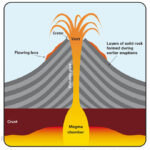Are Obsidian Rocks Worth Anything? Obsidian rocks, with their volcanic origins and glassy texture, hold a unique allure. At rockscapes.net, we delve into the factors influencing their worth, from rarity and color to potential uses in landscaping and jewelry. Discover how these fascinating rocks can add value to your collection or outdoor space.
1. What Exactly Is Obsidian?
Obsidian is a naturally occurring volcanic glass formed when felsic lava cools rapidly with minimal crystal growth. Its formation process gives it a smooth, uniform texture and a distinctive glassy appearance, making it a unique material in the world of rocks and minerals.
What are the key characteristics of obsidian?
Obsidian is primarily composed of silicon dioxide (SiO2), usually 70% or more. It is an extrusive rock, which means it forms on the Earth’s surface from rapidly cooling lava. This rapid cooling prevents the formation of crystals, resulting in obsidian’s characteristic amorphous (non-crystalline) structure. Obsidian is typically black, but it can also be found in other colors such as brown, green, and even iridescent varieties, depending on the presence of impurities and inclusions. Its hardness ranges from 5 to 6 on the Mohs scale.
Where is obsidian commonly found?
Obsidian is found in regions with a history of volcanic activity. Some of the most significant sources include the United States (particularly in states like Oregon, California, Arizona, and Idaho), Mexico, Iceland, Japan, and various parts of South America. In the US, Yellowstone National Park is also a notable location for obsidian. The specific type and quality of obsidian can vary depending on the geological conditions of each location.
2. What Factors Determine The Value Of Obsidian Rocks?
Several factors determine the value of obsidian rocks, much like other gemstones and minerals. These factors can be broadly categorized into rarity, appearance, and potential use. Let’s explore each of these aspects:
2.1. Rarity and Origin
The rarer the variety of obsidian, the higher its value. For instance, obsidian with unique colors or patterns, such as rainbow obsidian or fire obsidian, tends to be more valuable than the common black obsidian. Obsidian from specific, well-known locations may also command a premium, especially if the source is limited or the material has historical significance.
2.2. Color and Appearance
The color of obsidian significantly impacts its value. While black obsidian is the most common, other colors like green, blue, and reddish hues are rarer and more sought after. The presence of inclusions or unique patterns, such as the snowflake pattern in snowflake obsidian, can also increase its desirability and value. Iridescence, like that seen in rainbow obsidian, greatly enhances its appeal.
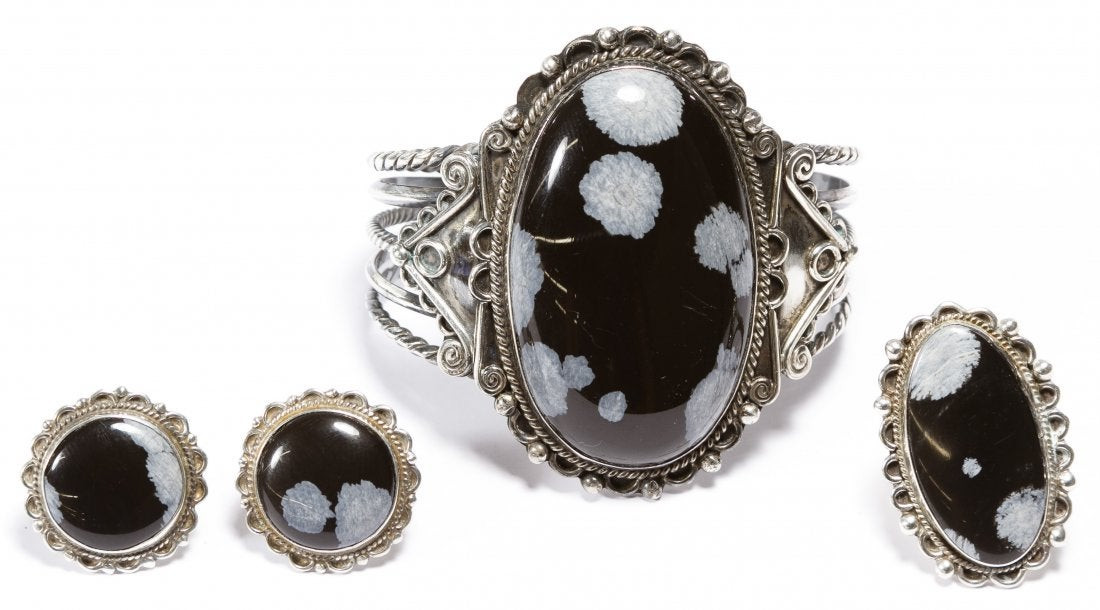 Snowflake obsidian under a macro lens, showcasing the unique snowflake-like spherulites of cristobalite
Snowflake obsidian under a macro lens, showcasing the unique snowflake-like spherulites of cristobalite
2.3. Size and Quality
Larger pieces of obsidian are generally more valuable, provided they are of high quality. Quality refers to the absence of significant flaws or inclusions that detract from the stone’s appearance. The quality of the polish and finish also matters if the obsidian has been worked into a cabochon, sculpture, or other decorative object.
2.4. Historical and Cultural Significance
Obsidian has been used for millennia by various cultures for tools, weapons, and ceremonial objects. Pieces with documented historical significance or cultural value can be highly prized by collectors and museums. For example, obsidian blades from ancient Mesoamerican cultures or artifacts found in significant archaeological sites can fetch high prices.
2.5. Market Demand
Like any commodity, the value of obsidian is also influenced by market demand. If there’s a high demand for obsidian in jewelry making, lapidary arts, or landscaping, the price will likely increase. Trends in design and fashion can also play a role in driving demand for specific types of obsidian.
2.6. Potential Uses
Obsidian’s value can also be tied to its potential uses. In landscaping, obsidian rocks can be used to create striking visual contrasts and add a unique textural element to gardens and outdoor spaces. In industry, obsidian has specialized applications, such as in the manufacturing of surgical tools because of its ability to create exceptionally sharp edges. These practical uses can contribute to its overall value.
3. Is Obsidian a Gemstone?
Yes, obsidian is often considered a gemstone, although it differs from traditional gemstones like diamonds or sapphires. Its unique properties and aesthetic appeal make it a popular choice for jewelry and ornamental purposes.
What qualities make obsidian a gemstone?
Obsidian is regarded as a gemstone due to its attractive appearance, which includes its glossy sheen and various colorations and patterns. It can be cut and polished into cabochons, beads, and faceted stones, making it suitable for use in jewelry. Additionally, certain varieties of obsidian, such as rainbow obsidian and snowflake obsidian, are particularly valued for their distinctive visual characteristics.
How does obsidian compare to other gemstones in terms of value?
Compared to precious gemstones like diamonds, rubies, and emeralds, obsidian is generally less valuable. This is because obsidian is relatively abundant and lacks the extreme hardness and brilliance of these more traditional gemstones. However, high-quality or rare types of obsidian can still fetch significant prices, especially when they are expertly crafted into jewelry or art objects.
4. What Are The Different Types Of Obsidian And Their Values?
Obsidian comes in several varieties, each with its unique appearance and characteristics. The value of these different types can vary widely based on their rarity, color, and patterns. Let’s explore some of the most popular types of obsidian and their approximate values:
4.1. Black Obsidian
Black obsidian is the most common type of obsidian and is readily available. It is typically inexpensive, with raw pieces selling for a few dollars per pound. Polished pieces and simple jewelry made from black obsidian can range from $10 to $50, depending on the size and craftsmanship.
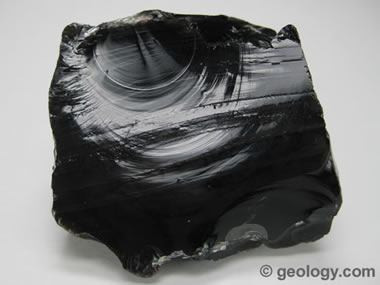 A polished black obsidian sphere, showcasing its smooth, reflective surface
A polished black obsidian sphere, showcasing its smooth, reflective surface
4.2. Snowflake Obsidian
Snowflake obsidian features white or gray snowflake-like patterns created by cristobalite inclusions. This variety is more valuable than plain black obsidian due to its unique appearance. Raw pieces can sell for $5 to $15 per pound, while polished stones and jewelry items may range from $20 to $80.
4.3. Rainbow Obsidian
Rainbow obsidian displays iridescent bands of color caused by magnetite nanoparticles. This type is highly prized for its vibrant play of color. Raw pieces can range from $10 to $30 per pound, while finished jewelry and decorative items can fetch prices from $50 to several hundred dollars, depending on the intensity and coverage of the iridescence.
4.4. Fire Obsidian
Fire obsidian is similar to rainbow obsidian but has even more intense and vibrant color layers. It is rarer and more valuable than rainbow obsidian. Prices for fire obsidian can range from $30 to $100 per pound for raw material, and finished pieces can sell for hundreds or even thousands of dollars, especially if the colors are vivid and well-defined.
4.5. Mahogany Obsidian
Mahogany obsidian is characterized by reddish-brown and black bands or swirls, caused by iron oxide inclusions. It is moderately priced, with raw pieces selling for $5 to $15 per pound. Polished stones and jewelry items can range from $20 to $60.
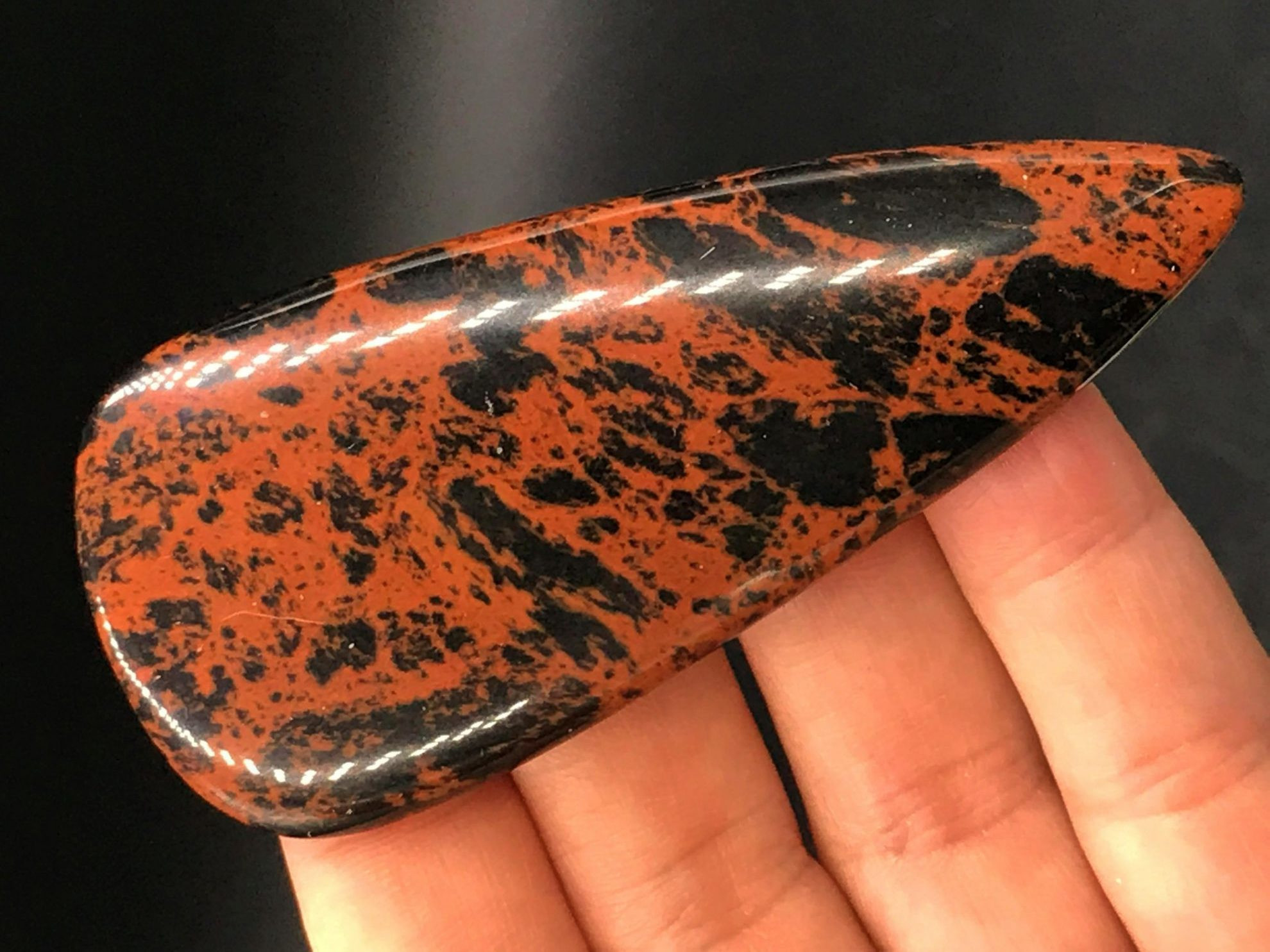 Mahogany obsidian cabochon
Mahogany obsidian cabochon
4.6. Sheen Obsidian
Sheen obsidian exhibits a silvery or golden sheen caused by gas bubbles within the stone. This type is valued for its subtle yet attractive luster. Raw pieces can sell for $8 to $20 per pound, while polished stones and jewelry items may range from $25 to $75.
4.7. Apache Tears
Apache tears are small, rounded nodules of black obsidian, often found within a grayish-white perlite matrix. They are relatively common and inexpensive, with prices typically ranging from $3 to $10 per pound. They are popular among beginner collectors and are often used in metaphysical practices.
The value ranges provided are approximate and can vary depending on the specific quality, size, and craftsmanship of the obsidian piece.
5. What Are The Uses Of Obsidian Rocks?
Obsidian rocks have a wide array of uses, ranging from practical tools to decorative elements and metaphysical objects. Its unique properties make it valuable in various fields.
5.1. Tools and Weapons
Historically, obsidian was highly valued for its ability to be flaked into extremely sharp blades. Ancient cultures used obsidian to create knives, arrowheads, spear points, and scrapers. Obsidian blades are sharper than steel scalpels, making them useful in surgical procedures even today.
5.2. Jewelry and Ornamentation
Obsidian is a popular material for jewelry making. It is cut and polished into cabochons, beads, pendants, and earrings. The different varieties of obsidian, such as rainbow, snowflake, and mahogany, add unique visual interest to jewelry pieces. Obsidian is also used in decorative objects like sculptures, carvings, and paperweights.
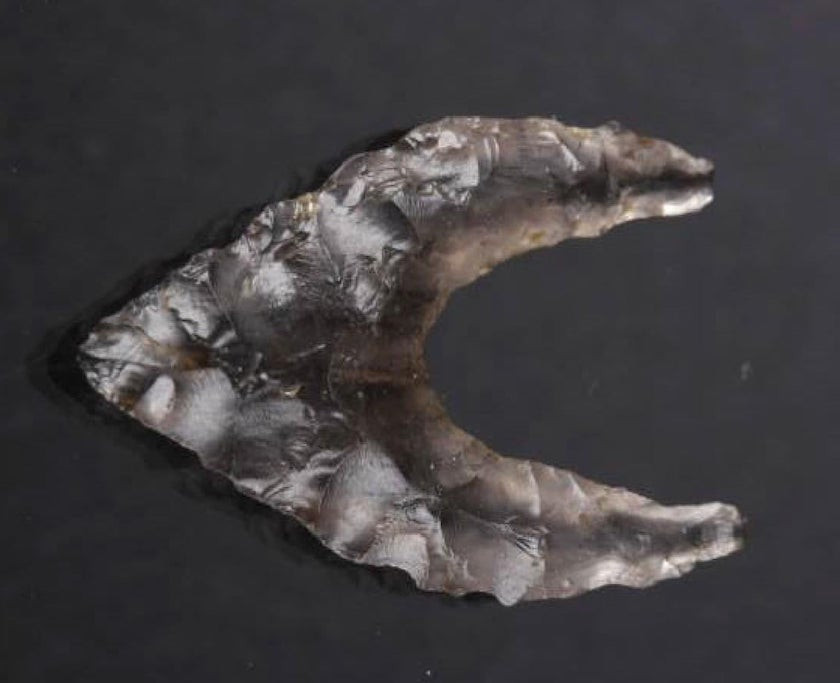 Obsidian bird-point arrowhead, from Japan
Obsidian bird-point arrowhead, from Japan
5.3. Landscaping
Obsidian rocks can be used in landscaping to create striking visual effects. They can serve as decorative ground cover, accent stones in gardens, or as part of water features. The dark, glassy appearance of obsidian contrasts beautifully with plants and other natural elements.
5.4. Metaphysical and Healing Practices
In metaphysical practices, obsidian is believed to have powerful protective and grounding properties. It is used to shield against negativity, promote clarity, and facilitate emotional healing. Obsidian is often used in meditation, energy work, and as a protective amulet.
5.5. Scientific Research
Obsidian is valuable in geological research. Its chemical composition and formation process provide insights into volcanic activity and the Earth’s history. Obsidian hydration dating, a method used to estimate the age of obsidian artifacts, is an important tool in archaeology.
5.6. Industrial Applications
Due to its sharpness, obsidian is used in some specialized industrial applications, such as in the manufacturing of precision cutting tools. Its unique properties are also explored for potential uses in nanotechnology and advanced materials.
6. How To Identify Real Obsidian?
Identifying real obsidian from imitations involves observing several key characteristics. Here are some reliable methods to help you determine if an obsidian rock is genuine:
6.1. Visual Inspection
Real obsidian has a glassy appearance with a smooth, conchoidal fracture. This means that when it breaks, it produces curved, shell-like surfaces. The color is typically black, but it can also be brown, green, or iridescent. If the material looks too perfect, uniform, or contains bubbles, it might be glass rather than obsidian.
6.2. Hardness Test
Obsidian has a hardness of 5 to 6 on the Mohs scale. It should be able to scratch glass but will be scratched by quartz (hardness of 7). If the material is easily scratched by glass, it is likely not obsidian.
6.3. Streak Test
Obsidian does not produce a streak when rubbed against a streak plate (unglazed porcelain). This is because it is harder than the streak plate. If the material leaves a streak, it is not obsidian.
6.4. Refractive Index (RI) Test
Gemologists use a refractometer to measure the refractive index of a gemstone. Obsidian typically has a refractive index of around 1.48 to 1.51. This test requires specialized equipment and is best performed by a professional.
6.5. Inclusions and Banding
Natural obsidian may contain inclusions or banding patterns. For example, snowflake obsidian has cristobalite inclusions, while rainbow obsidian has iridescent bands. These natural features are difficult to replicate in artificial glass.
6.6. Magnetic Test
Some obsidians, especially those containing magnetite, may exhibit a slight magnetic reaction. While not definitive, this can be an additional indicator of authenticity.
6.7. Consulting an Expert
If you are unsure about the authenticity of an obsidian rock, it is best to consult a professional gemologist or geologist. They have the expertise and equipment to accurately identify the material.
7. Where Can You Buy Obsidian Rocks?
If you’re looking to purchase obsidian rocks, you have several options, depending on the type and quality you desire. Here are some common places where you can find obsidian for sale:
7.1. Rock and Mineral Shops
Local rock and mineral shops are excellent places to find a variety of obsidian specimens. These shops often carry raw pieces, polished stones, and crafted items like jewelry and sculptures. The staff can provide information about the obsidian’s origin and properties, helping you make an informed purchase.
7.2. Gem and Jewelry Shows
Gem and jewelry shows are events where vendors from around the world gather to sell gemstones, minerals, and jewelry. These shows offer a wide selection of obsidian, from common black obsidian to rarer varieties like rainbow and fire obsidian. You can often find competitive prices and unique pieces at these events.
7.3. Online Marketplaces
Online marketplaces like Etsy, eBay, and Amazon host numerous sellers offering obsidian rocks. These platforms provide a convenient way to browse a vast selection of obsidian from the comfort of your home. However, it’s important to purchase from reputable sellers with positive reviews to ensure you are getting genuine obsidian.
7.4. Lapidary and Craft Suppliers
Lapidary and craft suppliers specialize in materials for jewelry making and stone cutting. They typically carry a variety of obsidian in different forms, such as slabs, cabochons, and beads. These suppliers are a good choice if you’re looking for obsidian to use in your own crafting projects.
7.5. Geological and Natural History Museums
Some geological and natural history museums have gift shops that sell mineral specimens, including obsidian. These museums often source their specimens from reputable suppliers and can provide accurate information about the obsidian’s geological context.
7.6. Rockhounding Sites
In certain areas with volcanic activity, you may be able to find obsidian yourself through rockhounding. States like Oregon, California, and Arizona have known obsidian collecting sites. Before you go, make sure to check local regulations and obtain any necessary permits.
8. How Is Obsidian Used In Landscaping?
Obsidian can be a striking addition to any landscape, adding visual interest and a unique textural element. Whether you’re aiming for a modern, minimalist design or a more natural, rustic look, obsidian can be incorporated in various creative ways. Here are some popular landscaping applications for obsidian rocks:
8.1. Decorative Ground Cover
Obsidian rocks can be used as a decorative ground cover in garden beds, pathways, and around trees. The dark, glossy surface of obsidian creates a beautiful contrast with green plants and colorful flowers. It also helps to suppress weed growth and retain moisture in the soil.
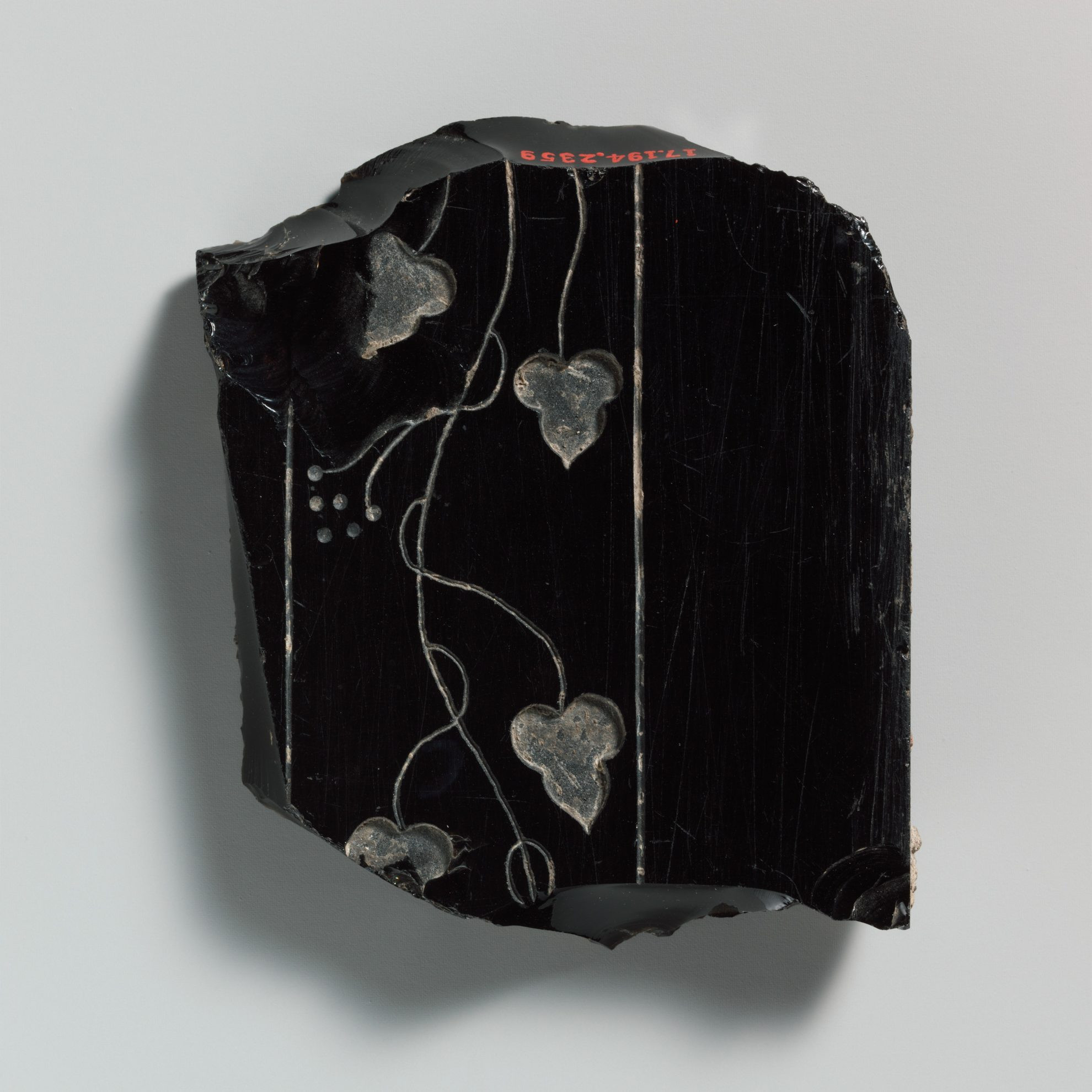 Obsidian fragments used as a decorative element in a garden setting, providing a sharp contrast with the greenery
Obsidian fragments used as a decorative element in a garden setting, providing a sharp contrast with the greenery
8.2. Accent Stones
Larger pieces of obsidian can serve as accent stones in a garden or landscape. They can be strategically placed to draw attention to specific areas, such as a water feature, a focal point plant, or an architectural element. The unique shapes and textures of obsidian add visual interest and depth to the landscape.
8.3. Water Features
Obsidian rocks are a natural choice for water features like fountains, ponds, and streams. The dark, reflective surface of obsidian enhances the beauty of the water and creates a serene, contemplative atmosphere. Obsidian can be used to line the edges of a water feature, create waterfalls, or as decorative elements within the water.
8.4. Rock Gardens
Obsidian is a perfect addition to rock gardens, where it can be combined with other types of rocks and drought-tolerant plants. The contrast between the dark obsidian and lighter-colored rocks creates visual interest, while the plants add a touch of softness and color.
8.5. Pathways and Walkways
Crushed obsidian or small obsidian rocks can be used to create pathways and walkways. The dark surface provides a clear visual path and adds a unique textural element to the landscape. Obsidian pathways are both functional and aesthetically pleasing.
8.6. Fire Pits and Fire Features
Obsidian rocks can be used around fire pits and fire features to create a dramatic and visually striking effect. The dark, reflective surface of obsidian contrasts beautifully with the flames, creating a warm and inviting atmosphere.
9. Obsidian In Arizona: What Makes It Special?
Arizona is a significant location for obsidian, with several sites known for producing high-quality material. The geological history of Arizona, marked by extensive volcanic activity, has created ideal conditions for the formation of obsidian. Here’s what makes obsidian in Arizona special:
9.1. Abundance and Variety
Arizona boasts several obsidian deposits, offering a variety of types and colors. Black obsidian is the most common, but you can also find mahogany obsidian, snowflake obsidian, and even rare varieties with iridescent sheens. The abundance and variety of obsidian in Arizona make it a popular destination for rockhounds and collectors.
9.2. Apache Tears
Arizona is famous for Apache tears, small, rounded nodules of black obsidian found within a grayish-white perlite matrix. These nodules are relatively common in Arizona and are popular among beginner collectors. According to a legend of the Native American Apache people, these nodules represent the tears of Apache women mourning the loss of their warriors.
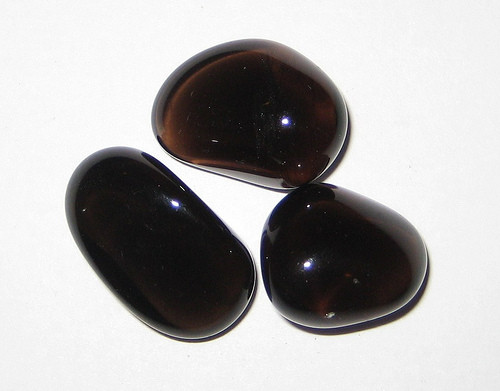 Apache tears obsidian, a variety commonly found in Arizona, known for its small, rounded nodules
Apache tears obsidian, a variety commonly found in Arizona, known for its small, rounded nodules
9.3. Geological Significance
The obsidian deposits in Arizona provide valuable insights into the state’s volcanic past. Geologists study these deposits to understand the timing and nature of volcanic eruptions, as well as the processes involved in the formation of obsidian. The obsidian in Arizona also helps researchers learn more about the geological history of the southwestern United States.
9.4. Accessibility
Many obsidian collecting sites in Arizona are relatively accessible, making it easy for hobbyists and researchers to gather specimens. However, it’s important to check local regulations and obtain any necessary permits before collecting obsidian on public lands.
9.5. Economic Importance
The obsidian deposits in Arizona have economic importance, supporting local rock shops, gem and mineral shows, and lapidary businesses. Obsidian is also used in landscaping and construction projects, contributing to the state’s economy.
10. Obsidian For Beginners: Tips And Tricks
If you’re new to working with obsidian, here are some tips and tricks to help you get started:
10.1. Safety First
Obsidian can be very sharp, so always wear safety glasses and gloves when handling it. Use caution when cutting, grinding, or polishing obsidian to avoid injury.
10.2. Start with Common Varieties
Begin with common varieties like black obsidian or snowflake obsidian, which are more readily available and less expensive. This will allow you to practice your techniques without worrying about damaging rare or valuable specimens.
10.3. Use Proper Tools
Use tools specifically designed for working with stone, such as diamond blades, grinding wheels, and polishing pads. These tools will help you achieve the best results and minimize the risk of damaging the obsidian.
10.4. Keep it Cool
Obsidian can overheat and fracture if it gets too hot during cutting or grinding. Use plenty of water as a coolant to keep the obsidian cool and prevent damage.
10.5. Take Your Time
Working with obsidian requires patience and attention to detail. Take your time and work slowly to avoid mistakes. Practice your techniques on scrap pieces before working on valuable specimens.
10.6. Polish to a High Shine
Obsidian is known for its glassy luster, so aim for a high shine when polishing it. Use progressively finer grits of polishing compound and finish with a polishing cloth or buffing wheel.
10.7. Learn from Experts
Take classes or workshops from experienced lapidaries or jewelers to learn advanced techniques for working with obsidian. You can also find helpful tutorials and resources online.
10.8. Experiment with Different Finishes
Experiment with different finishes to see what works best for your projects. You can try cabochons, faceted stones, carvings, or even rough, natural pieces.
FAQ: Frequently Asked Questions About Obsidian
Is obsidian a mineral or a rock?
Obsidian is a rock. More specifically, it is an extrusive igneous rock that forms from rapidly cooled lava. While it is composed of minerals, particularly silica, its non-crystalline structure classifies it as a rock rather than a mineral.
Can obsidian be scratched?
Yes, obsidian can be scratched. It has a hardness of 5 to 6 on the Mohs scale, meaning it can be scratched by materials with a higher hardness, such as quartz (hardness of 7).
Is obsidian magnetic?
Some obsidian can exhibit a slight magnetic reaction, particularly if it contains magnetite inclusions. However, not all obsidian is magnetic, and the strength of the magnetic reaction can vary.
How can you tell if obsidian is fake?
You can identify real obsidian by its glassy appearance, conchoidal fracture, and hardness. Fake obsidian may look too perfect, contain bubbles, or be easily scratched.
What is snowflake obsidian used for?
Snowflake obsidian is used for jewelry making, decorative objects, and metaphysical purposes. It is believed to promote balance, clarity, and emotional healing.
Is rainbow obsidian rare?
Rainbow obsidian is rarer than black obsidian but not as rare as fire obsidian. Its iridescent colors make it highly prized for jewelry and decorative items.
Where is obsidian most commonly found?
Obsidian is most commonly found in regions with a history of volcanic activity, such as the United States (Oregon, California, Arizona), Mexico, Iceland, and Japan.
How is obsidian formed?
Obsidian is formed when felsic lava cools rapidly with minimal crystal growth. This rapid cooling results in its characteristic glassy texture and amorphous structure.
What are Apache tears made of?
Apache tears are small, rounded nodules of black obsidian, often found within a grayish-white perlite matrix.
Can obsidian be recycled?
Obsidian is not typically recycled in the same way as glass or metal. However, it can be repurposed for landscaping, decorative purposes, or in certain industrial applications.
Ready to Explore the Beauty of Obsidian?
Obsidian rocks, with their fascinating origins and diverse applications, offer something for everyone. Whether you’re a seasoned collector, a landscape designer, or simply someone who appreciates the beauty of natural stones, obsidian can add value and interest to your life.
At rockscapes.net, we’re passionate about showcasing the beauty and versatility of rocks in landscaping and beyond. Explore our website for more inspiration, information, and resources on incorporating rocks into your outdoor spaces. From design ideas to practical tips and expert advice, we’re here to help you create the landscape of your dreams.
Ready to get started? Contact us today to discover the perfect obsidian rocks for your next project!
Address: 1151 S Forest Ave, Tempe, AZ 85281, United States
Phone: +1 (480) 965-9011
Website: rockscapes.net
